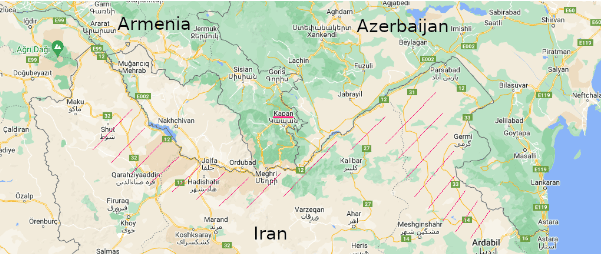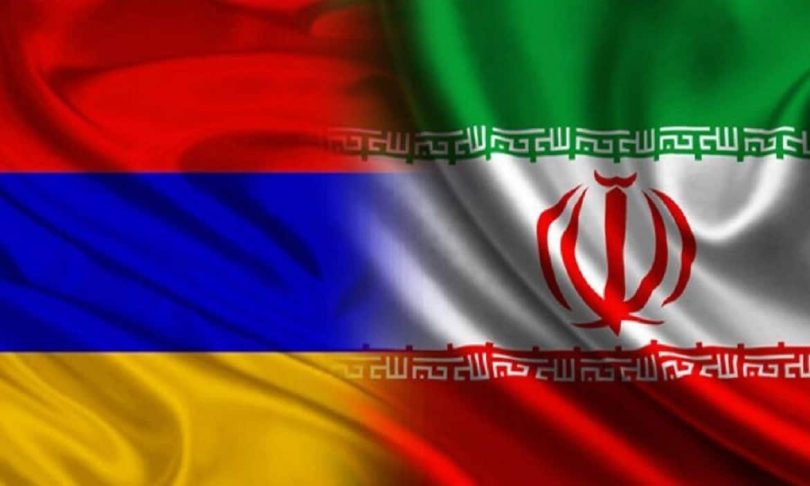On numerous occasions over the past several weeks and extending back almost two years, high officials of the Iranian government have claimed that any border change between Armenia and Iran at the behest of Azerbaijan and Turkey would represent an existential threat to Iran.
A border change would symbolize capitulation to the Azerbaijani demand for constructing a ‘corridor’ between rump Azerbaijan and its exclave of Nakhichevan, crossing Armenia. (Access roads exist worldwide; for example, Campione d’Italia’s exclave in Switzerland). However, Baku has strongly implied or demanded that this road shall not be under Armenian sovereignty. Effectively, such a transport route could cut off Armenia from its regions south of such a road, extending to the Iranian border. Tehran has stated that such a move would be an existential threat to Iran as it would result in the placement of NATO forces across the entire stretch of its northwest border; such a ‘corridor’ could be used to move NATO-Turkish weaponry into Azerbaijan proper. As it is, Azerbaijan already hosts Israeli bases whose function is intelligence-gathering on Iran and forward deployment of armament that can be used against Iran. Despite the fact that Azerbaijan denies all such claims, but the evidence tells another story.

It is beyond this short article’s scope to analyze the defeat of the Armenians of Nagorno-Karabakh in the 2020 Azerbaijan offensive wherein the latter’s goal was to capture what it considers its sovereign territory, leaving only a small portion of this Armenian-inhabited region remaining. While the vast majority of the soldiers participating were Azerbaijani, the battle against the Armenians was functionally run by the Turkish military, and included Turkish weaponry and imported ISIS jihadists. Russian soldiers now protect the Armenians remaining just inside the Azerbaijan border. Since the 2020 war, Azerbaijani forces have penetrated, and remain, within Armenia’s recognized boundaries.
In September of 2022, Azerbaijani troops ventured into Armenian territory, bombing civilian facilities, killing hundreds, and forcing over seven thousand Armenians to flee. This Azerbaijani attack on Armenia manifested as the former’s attempt to militarily create their ‘corridor’ or capture all of southern Armenia — the land between rump Azerbaijan and Nakhichevan — via military force. The significant degradation of Armenia’s military as a result of its 2020 defeat, in combination with the regressive policy of its government’s claim that a robust military would seem too threatening to its neighbors — as well as a Soviet-like command structure — made it appear as if Armenia was unable to protect its borders. Armenia’s diplomatic corps was unable or unwilling to use the same argument Azerbaijan used to capture Nagorno-Karabakh; that is, the inviolability of recognized international borders. Hypocrisy aside, not even the CSTO came to Armenia’s rescue.
It is difficult to believe that Russia was so bogged down in Ukraine it could not at least diplomatically reprimand Azerbaijan. Concurrently, other CSTO members also stated their refusal to honor the CSTO treaty. This development demonstrated that CSTO is not a military pact but a political one inconsistently implemented at the whim of the Kremlin. This reality was highlighted via the comments of Belarusian President Alexander Lukashenko during a CSTO Collective Security Council session on October 28, 2022 that served to reveal that entity’s impotence.
The lead hypothesis regarding Russia’s lack of responsiveness in the 2020 Karabakh war (and by extension the September Azerbaijani incursion), is that its inaction was representative of a quid pro quo with Turkey. Supposedly Armenia’s strategic partner, Russia further enjoys benefits from an east-west transport link through Armenia, as do Turkey and Azerbaijan. During the Azerbaijan incursion into Armenia in the fall of 2022, Russia appeared neutral while allowing American and EU efforts to secure an end to hostilities, as both of those parties demanded that Azerbaijani troops return to their side of the border. This attempt at diplomacy occurred after the loss of hundreds of Armenian lives, the mutilation of female Armenian soldiers, and the outright murder of Armenian POWs — all of which was proudly displayed on Azerbaijani telegram channels. Azerbaijani gas is being used to incrementally compensate for the loss of Russian gas supplies to the EU. As a result, Baku’s traditional caviar diplomacy and anti-Armenian aggression are tolerated in many circles.
Azerbaijan’s acquisition of approximately 138 km of borderland with Iran allowed for greater direct surveillance of Iran from Azerbaijan. Azerbaijan continues to reap not only praise from Israel for capturing land at the Iranian border, but benefits from the involvement of Israeli companies in construction and infrastructure projects (along with Turkish and Italian firms). For obvious reasons, this has angered Iran. In October 2021, Iran began an unprecedented buildup of forces at the Iranian-Azerbaijani border, particularly following the opening of an airport in the captured town of Fizuli, at which Israeli reporters were in attendance. Israeli intelligence would be remiss in its duties by neglecting to convince the Azerbaijanis of the ‘wisdom’ of placing surveillance equipment in this newly-captured land — especially with respect to airport-related devices. On September 23, 2022, Iranian authorities arrested a terrorist team smuggling lethal weapons into Iran from Azerbaijan; on October 24, 2022, Iranian authorities arrested ten people on charges of working for Israel’s Mossad.
Following the Azerbaijani incursion into Armenia proper this past September, Iran again started to voice concerns about any changes in the Armenian-Iranian border as represented by a short, 44-km strip of land. This concern increased in frequency amidst its consistent tone, reflecting the reality that for thousands of years, Iranian and Armenian peoples shared borders.
Iran’s support for Armenian sovereignty goes beyond the fallacious simple-minded proverb, “the enemy of my enemy is my friend;” in fact, its genesis goes back almost two thousand years. Rather than Persia (Iran’s historical name) absorbing Armenia, the Persians allowed Armenia to exist even if satraps ruled parts of Armenia. Armenians could have easily ended up as a footnote of history, considering their homeland was a battleground between ancient Greeks and Persians. A related counter argument claims that four hundred years ago during a war with the Ottoman Empire, Persian Shah Abbas I forced over 150,000 Nakhichevan Armenians from their homes for resettlement in New Julfa, a nascent city just outside Isfahan. Less than half the Armenians survived the ordeal.
During a meeting with the Armenian foreign minister on October 20, 2022, Iranian Foreign Minister Hossein Amir-Abdollahian, stated:
“We consider Armenia’s security as the security of the Islamic Republic of Iran and the security of the region.”
Further, on October 13, 2022, President Raisi made Iran’s position clear to President Aliyev of Azerbaijan in a face-to-face meeting at the Conference on Interaction and Confidence-Building Measures in Asia (CICA) summit in Kazakhstan, stating:
“…any change in historical borders, regional geopolitics and Iran-Armenia transit routes is not tolerable. Also any European military presence under any guise is rejected.”
The deputy coordinator of the ground forces of the Islamic Revolutionary Guard Corps, Sardar Ali Akbar Pourjamshidian stated, “The people of Azerbaijan and Armenia are not a threat to us, they are our neighbors, but what is a threat is the events that are happening there and the presence of the Zionists and NATO there, and we will not ignore this issue.” He noted, “Changing the borders is very important; the country of Azerbaijan achieved what it was looking for and Karabakh was liberated and we congratulated it, but today if there is an aggression and our borders change and the ways of connecting Iran to Europe are damaged for thousands of years, we are sensitive and will take decisive action.”
Naysayers might be quick to call this simple opportunism, but in October 2022, Iran conducted drills on the border with Azerbaijan for the second time in two years. These were not simple drills and appear to have been more extensive than earlier ones, and included the deployment of pontoon bridges across the Aras River near the Azerbaijani border. Further, the Iranian soldiers at the Aras River were Iran’s Revolutionary Guard. This deployment occurred through much of the Azerbaijani-speaking regions of northwestern Iran, stretching from Ardabil to Nakhichevan. (Please see the accompanying map). Essentially, Azerbaijan was given notice.
On October 21, 2022, Iran opened a consulate in the southern Armenian town of Kapan. Though not an event noted by the world diplomatic community beyond an opportunity to vilify Armenia, it placed an Iranian consulate within eyeshot of the Azerbaijani border.
Russia has its interests and many have become parallel to those of Turkey, at Armenia’s expense. Turkey is NATO’s local representative and attack dog, at least for the time being. Azerbaijan is still solidifying its national ethos, again at Armenia’s expense. Azerbaijan has been given carte blanche as it has incrementally added to the EU’s self-imposed gas shutoff from Russia. US interest in Armenia is centered on dismantling the Russian Federation since Armenia has little to offer otherwise. To the north of Armenia, non-hostile Georgia has conflated the tactical goal of joining NATO (or at least the EU), with a national strategy.
Anecdotally referred to as the ‘Washington Document,” a missive circulating on the Internet describes, on a single page, the basis for an agreement between Secretary of Armenia’s Security Council Armen Grigoryan and Azerbaijani Presidential Aide Hikmet Hajiyev. The document in question was purportedly written in a late September 2022 meeting mediated by US National Security Adviser Jake Sullivan in Washington, DC. On paper, it appears to symbolize complete Armenian capitulation. Conversely, some in the Armenian public interpret it as another indication of an Armenian turn to the West, fueled by Western-sponsored NGOs in Armenia that have not been reprimanded by the Armenian government.
With respect to the ‘Washington Document,’ if what remains of Nagorno-Karabakh becomes an internal Azerbaijani issue exclusive of Armenia, perhaps Russian troops will not be necessary for Armenia’s protection. Even outspoken Russians who ‘dare’ utter the words ‘Nagorno-Karabakh’ or Artsakh (the Armenian name for this region) have been recently banned from Armenia. Armenia’s capitulation knows no limits. Such events are not welcomed in Iran, as any change in Armenia’s orientation would require a zero-sum position paralleling that of Georgia’s relationship with Russia. The West would have it no other way. Any secret agreements, promises, or quid pro quos made between the parties are, as yet, unknown. Were hints given to Armenia that regime change in Iran is imminent?
Even though Armenia’s foreign minister has stated that ties with Iran are “strategic,” Armenia lacks sufficient diplomacy and strategic depth to develop Iran-Armenia relations beyond words — regardless of which orientation Armenia agrees or is forced to concede to (presupposing the Iranian regime survives in the short term). Although the collective West has sanctioned Iran to the bleeding point, Armenia could gain much if it engaged Iran with far less fanfare (assuming it had a strategy and did not hang its hopes on transactional decision-making).
It is unclear if Armenia’s ruling class would accept weaponry and military intelligence from Iran even if Turkey and Azerbaijan attempted to capture the internationally-recognized south of Armenia. The fear that Armenia would be denounced as a pariah state might overwhelm its ability to make prudent decisions. The pan-Turkic goal is the direct connection of rump Azerbaijan with Nakhichevan, the latter already having a small border with Turkey. It is clear from the Iranian press that Tehran would theoretically defend its border with Armenia from becoming Azerbaijani, including unilaterally sending troops into Armenia. However, the Iranians are entirely rational players, and unless the survival of the Iranian regime is threatened, the Iranians will not cross Armenian or Azerbaijani borders.
Armenia cannot afford to make diplomatic mistakes as its enemies about seventy percent of its borders, leaving it only sanctioned Iran to its south and NATO/EU wannabe Georgia to its north as ‘friendlies.’
Yerevan, Armenia
Author: David Davidian (Lecturer at the American University of Armenia. He has spent over a decade in technical intelligence analysis at major high technology firms. He resides in Yerevan, Armenia).



